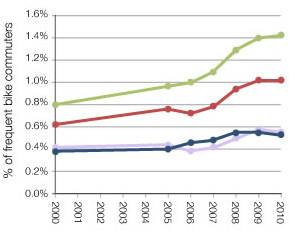According to data from the US Census Bureau’s American Community Survey, these were the bicycle commuting rates in the most populous Kansas cities in 2010:
- Kansas City: 0.1%
- Lawrence: 2.2%
- Olathe: 0.2%
- Overland Park: 0.2%
- Topeka: 0.4%
- Wichita: 0.5%
And here are the rates for cities in our neighboring states:
Arkansas:
- Fayetteville: 0.4%
- Little Rock: 0.1%
Colorado:
- Arvada: 0.4%
- Aurora: 0.4%
- Boulder: 9.9%
- Centennial: 0.2%
- Colorado Springs: 0.6%
- Denver: 2.2%
- Fort Collins: 4.4%
- Greeley: 0.6%
- Lakewood: 0.3%
- Longmont: 1.5%
- Pueblo: 0.6%
- Thornton: 0.5%
- Westminster: 0.4%
Iowa:
- Cedar Rapids: 0.7%
- Des Moines: 0.4%
- Iowa City: 5.6%
- Sioux City: 0.2%
Missouri:
- Columbia: 1.5%
- Kansas City: 0.3%
- Springfield: 1.2%
- St. Louis: 0.9%
Nebraska:
- Lincoln: 1.6%
- Omaha: 0.1%
Oklahoma:
- Norman: 0.7%
- Oklahoma City: 0.3%
- Tulsa: 0.2%
Nationwide, the top bicycle commuting cities are:
- Davis, California: 22.1%
- Boulder, Colorado: 9.9%
- Eugene, Oregon: 8.3%
- Berkeley, California: 8.0%
- Cambridge, Massachusetts: 6.8%
- Santa Barbara, California: 6.4%
- Madison, Wisconsin: 6.0%
- Gainesville, Florida: 6.0%
- Portland, Oregon: 6.0%
- Iowa City, Iowa: 5.6%
It’s good to see some cities from our region on the top-ten list.
But Kansas: We have some catching up to do!
 Learn more about the data from the League of American Bicyclists.
Learn more about the data from the League of American Bicyclists.
They note that there are several very important caveats to the data:
- The ACS asks only about commuting. It does not tell us about bicycling for non-work purposes.
- Results are based on a survey of a sample of the population. Surveys take place throughout the year. The journey to work question asks respondents about the previous week.
- The journey to work question asks about the primary mode of transportation to work. The wording of the question undercounts the actual amount of bike commuting that occurs. It does not count people who rode once or twice a week or people who bike to transit (if the transit leg is longer than the bike leg).
Still, this data is interesting, if nothing else…
Post tags: NewsBlog


